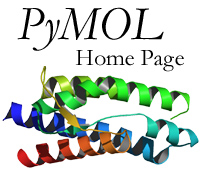PyMOL is open-source, user-sponsored, molecular graphics system with an embedded Python interpreter designed for real-time visualization and rapid generation of high-quality molecular graphics images and animations. PyMOL is scriptable and can be extended using the Python language. PyMOL is an active project, and there are new features being added to it frequently. open in new windowPyMOL web site Home page.
| Last update: | 8 June 2010, Version 1.3 | ||
|---|---|---|---|
| Platforms: | Windows, Mac OSX, Unix, Linux | ||
| Charge: | Access to precompiled PyMOL buildsis now limited to paying customers only. However, the current source code continues to be available at no cost as are older precompiled builds. Precompiled PyMOL builds available at no cost also to teachers or full-time students upon registration. |
||
| Documentation: |
|
||
| Development: | DeLano Scientific LLC | ||
| Plugins | Plugins are user-developed modules that extend PyMOL's capabilities. In order to use the plugins, you'll need an Tcl/Tk-based version of PyMOL (on Macs, this means either the Fink or X11/Hybrid versions ). For installation instruction see PyMOL manual. | ||
| open in new windowAPBS Tools | Tool to calculate and visualize the electrostatic properties of biomolecular systems by numerical solution of the Poisson-Boltzmann equation (PBE). (require APBS installation) | ||
| open in new windowCAVER | Tool for identifying and visualizing access routes to protein cavities | ||
| open in new windowCOLORAMA | PyMOL plugin which allows to color objects using adjustable scale bars | ||
| A storyboard-based tool for molecular movies | |||
| GPSSpyMOL | A tool for visualizing surfaces and voids using the CASTp algorithm | ||
| open in new windowPocketPicker | Grid-based technique for the analysis of protein pockets. | ||
| open in new windowVASCo | A tool for visualizing of annotated protein surface contacts (elctrostaticss, hydrophobicity, contact patch) | ||
| Voronoia | Calculation and visualization of packing densities in protein structures | ||
























